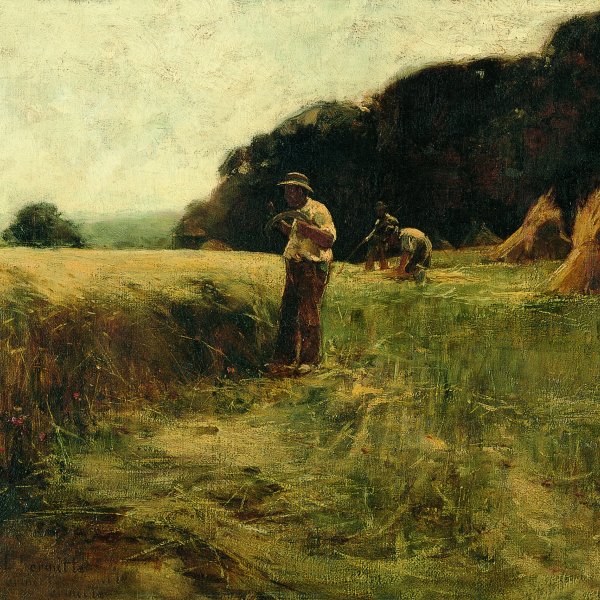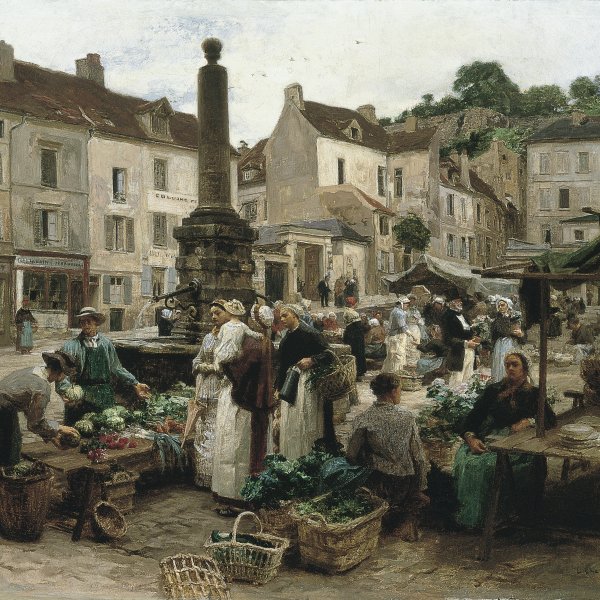Léon-Augustin Lhermitte
Mont Saint-Père, 1844 -París, 1925
Léon Lhermitte was born on 31 July 1844 at Mont-Saint-Père in the French region Aisne, as the son of a school teacher. In 1863 he went to Paris as a pupil of the École Impériale de Dessin, where he had the same teacher as Rodin, the well known Lecoq de Boisbaudran who gave a course in dessin par la mémoire. A year later one of his drawings was admitted at the Salon in Paris; his first painting was accepted in 1866. In that same year he was invited to illustrate Frédéric Henriet's book, Paysagiste aux champs. In 1869 he went to London where he met Alphonse Legros, who eventually introduced him to the art dealer Paul Durand-Ruel. Lhermitte's works sold well at Durand-Ruel's gallery in New Bond Street.
One of his paintings The Harvest was awarded with a medal at the Paris Salon of 1874. In that period he made several trips to Bretagne. He also became a close friend to the painter Henner. Degas invited Lhermitte to participate in the fourth exhibition of the Impressionists, but Lhermitte refused. He bought a house in his birthplace. His painting The Payment of the Harvesters was one of the highlights of the collection of the new Musée du Luxembourg in Paris. Lhermitte had become a famous modern artist; among his admirers were Rodin, Vincent van Gogh and Puvis de Chavannes. The art gallery Boussod, Valadon et Cie., signed a contract with Lhermitte for the exclusive rights to sell his paintings. Boussod and Valadon were the successors of the famous Goupil Gallery, which employed both Vincent van Gogh and his brother Theo as sales assistants. The French Government asked Lhermitte to decorate the Salle des Commissions in the Sorbonne. Under pressure from his old friend Cazin, Lhermitte became a member of the newly founded Société Nationale des Beaux-Arts. In Munich however he participated with enthusiasm in the exhibition of the Secession with artists such as Max Liebermann, Josef Israëls, Anton Mauve and Munkascy. The city of Paris invited him to make a monumental painting for the decoration of the new Hôtel de Ville, with the most ambitious of his market scènes, called Les Halles. At the Exposition Universelle of 1900 in Paris Lhermitte was represented with seven paintings. He was created officer of the Légion d'Honneur; in 1905 he succeeded Henner as member of the Académie des Beaux-Arts. After the Great War his health, which had never been very good, deteriorated and made it very difficult for him to continue his work. In his last years he only produced some pastels.
He died on 28 July 1925, and he was buried at Mont-Saint-Père, the place where he was born.
John Sillevis
One of his paintings The Harvest was awarded with a medal at the Paris Salon of 1874. In that period he made several trips to Bretagne. He also became a close friend to the painter Henner. Degas invited Lhermitte to participate in the fourth exhibition of the Impressionists, but Lhermitte refused. He bought a house in his birthplace. His painting The Payment of the Harvesters was one of the highlights of the collection of the new Musée du Luxembourg in Paris. Lhermitte had become a famous modern artist; among his admirers were Rodin, Vincent van Gogh and Puvis de Chavannes. The art gallery Boussod, Valadon et Cie., signed a contract with Lhermitte for the exclusive rights to sell his paintings. Boussod and Valadon were the successors of the famous Goupil Gallery, which employed both Vincent van Gogh and his brother Theo as sales assistants. The French Government asked Lhermitte to decorate the Salle des Commissions in the Sorbonne. Under pressure from his old friend Cazin, Lhermitte became a member of the newly founded Société Nationale des Beaux-Arts. In Munich however he participated with enthusiasm in the exhibition of the Secession with artists such as Max Liebermann, Josef Israëls, Anton Mauve and Munkascy. The city of Paris invited him to make a monumental painting for the decoration of the new Hôtel de Ville, with the most ambitious of his market scènes, called Les Halles. At the Exposition Universelle of 1900 in Paris Lhermitte was represented with seven paintings. He was created officer of the Légion d'Honneur; in 1905 he succeeded Henner as member of the Académie des Beaux-Arts. After the Great War his health, which had never been very good, deteriorated and made it very difficult for him to continue his work. In his last years he only produced some pastels.
He died on 28 July 1925, and he was buried at Mont-Saint-Père, the place where he was born.
John Sillevis






